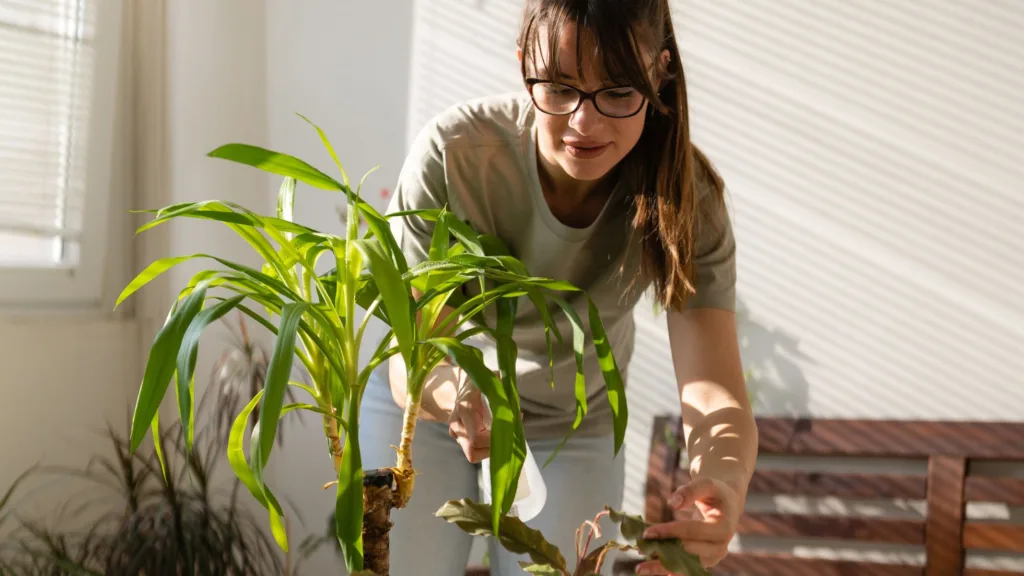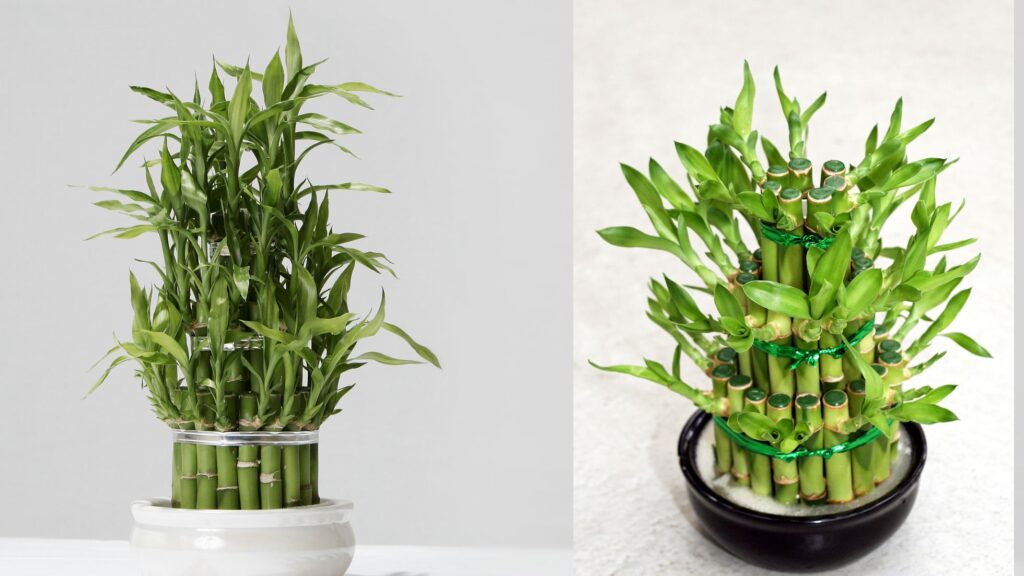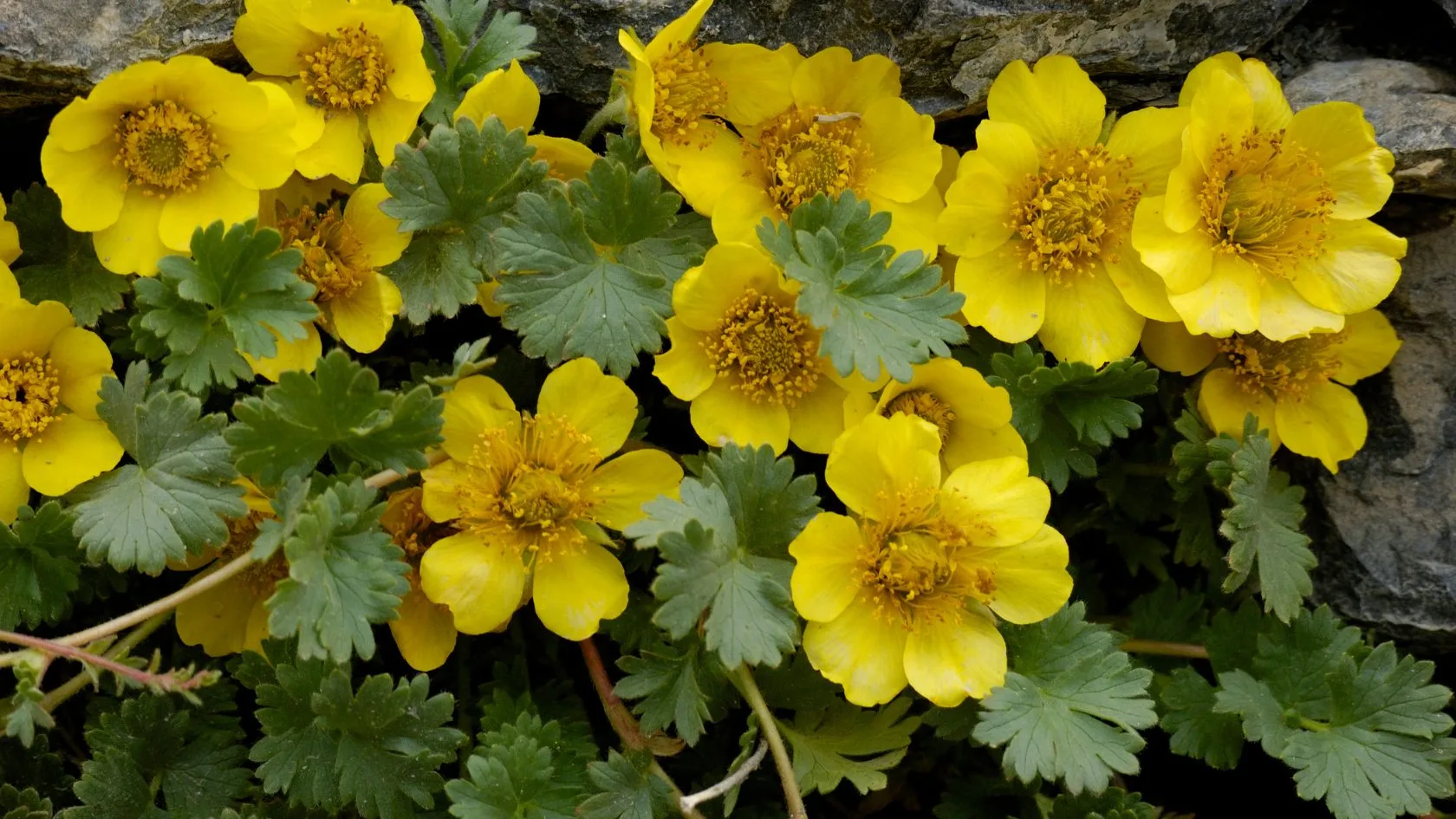Bamboo plants are popular as decorative plants because they look beautiful, grow quickly, and have cultural meanings. These plants are in the grass family (Poaceae) and are grown for both their looks and their many useful properties.

Types of Bamboo Plant
- Phyllostachys aurea
- Phyllostachys nigra
- Bambusa vulgaris
- Fargesia sp.
- Phyllostachys bambusoides
- Dendrocalamus strictus
- Chusquea culeou
- Pleioblastus viridistriatus
- Semiarundinaria fastuosa
- Borinda species
Benefits Bamboo plant
Bamboo plants offer numerous benefits, both environmentally and economically.
Soil Erosion Prevention: Bamboo’s large root system stabilizes soil and prevents erosion. Bamboo on slopes, riverbanks, and other sensitive sites helps prevent erosion and soil degradation.
Air purification: Bamboo absorbs carbon dioxide and releases oxygen, purifying the air. Additionally, they may remove atmospheric pollutants including benzene and formaldehyde.
Water Conservation: Bamboo uses less water than most crops. High water efficiency means they survive with little watering. Bamboo is ideal for drought-prone areas.
fastest-growing: Bamboo is one of the fastest-growing plants. This implies that you may enjoy a lush, complete plant in a relatively short length of time.
Simple to maintain: Bamboo plants are among the easiest houseplants to care for. They require little water and may thrive in a variety of lighting environments.
Disadvantages of Bamboo plant
While bamboo plants offer numerous advantages, there are also some disadvantages to consider.
Maintenance: Although bamboo is generally low-maintenance, certain species require regular pruning to prevent overgrowth and maintain desired shapes. Without proper care, bamboo can become unruly and difficult to manage.
Limited Varieties for Cold Climates: Many bamboo species are not cold-hardy and may not survive in regions with harsh winters. This limits their use in landscaping for areas with cold climates.
Upkeep challenges: The fast-growing nature that’s a benefit can also be a challenge. Bamboo requires constant vigilance to keep it from spreading uncontrollably. You’ll need to regularly remove new shoots and maintain root barriers to confine it.
Bamboo Plants Care
Taking care of bamboo plants involves several key steps to ensure their health and vitality:
Watering: Bamboo plants require consistent moisture, especially during dry periods. Water deeply and regularly, ensuring that the soil remains consistently moist but not waterlogged.
Soil: Bamboo plants thrive in well-draining, fertile soil. Amend heavy clay soils with organic matter like compost to improve drainage and fertility. Ensure the soil pH is within the optimal range for bamboo, which is typically slightly acidic to neutral.
Fertilization: Bamboo plants benefit from regular fertilization to support their rapid growth. Apply a balanced, slow-release fertilizer in spring or early summer, following the manufacturer’s instructions. Avoid over-fertilizing, as this can lead to excessive leaf growth at the expense of culm development.

Propagation of Bamboo Plant
Division: This method involves separating a mature bamboo plant into smaller sections, each with its own rhizome system. To divide bamboo, carefully dig up the plant and use a sharp spade or saw to cut through the rhizomes, ensuring that each division has several healthy culms and roots attached. Replant the divisions in prepared soil, keeping them well-watered until they establish roots.
Rhizome Cuttings: Rhizome cuttings involve taking sections of the underground rhizome system and planting them to grow new bamboo plants. To propagate bamboo using rhizome cuttings, select healthy rhizome sections with at least one node (the point from which new shoots emerge) and several roots attached. Plant the rhizome cuttings horizontally in a prepared planting bed or container, covering them with soil and keeping them consistently moist until new shoots emerge.
Seeds: While less common, bamboo can also be grown from seeds. However, bamboo seeds can be challenging to germinate and may have variable success rates. To propagate bamboo from seeds, collect ripe seeds from mature bamboo plants and soak them in water for several days to soften the outer shell.
Repotting of Bamboo Plant
Repotting bamboo plants is necessary when they outgrow their current container or when the soil becomes depleted of nutrients. Here’s a step-by-step guide to repotting bamboo:
Choose the Right Time: The optimal time to report bamboo is in the spring or early summer when the plant is actively developing. Avoid repotting during the dormant season or harsh weather conditions.
Select a New Container: Choose a new container that is somewhat larger than the present one, enabling room for the bamboo’s roots to expand.
Prepare the New Pot: Place a layer of tiny stones or gravel at the bottom of the new pot to increase drainage. Add a layer of new, well-draining potting mix on top, giving enough room to accommodate the bamboo’s root ball.
Remove the Bamboo Plant: Carefully remove the bamboo plant from its present container by gently flipping it over and slipping the root ball out. If the plant is root-bound, gently peel apart the roots to stimulate outward development.
Inspect the Roots: Take this chance to inspect the bamboo roots for any symptoms of illness or injury. Trim away any dead or rotten roots using sterile pruning shears.
Place the Bamboo in the New Pot: Position the bamboo plant in the center of the new pot, ensuring that it rests at the same depth as it was in the previous container. Add extra potting mix around the sides of the root ball, gently pushing it down to eliminate air pockets.
Water Thoroughly: After repotting, thoroughly water the bamboo plant to settle the soil and hydrate the roots. Allow any extra water to drain out freely.
Provide Care: Place the repotted bamboo plant in a location with acceptable sunshine and temperature conditions. Continue to water frequently and check for symptoms of stress, such as yellowing leaves or wilting.
Fertilize as Needed: Once the bamboo has adjusted to its new container, resume fertilizing with a balanced, slow-release fertilizer according to the manufacturer’s directions.
Bamboo Plant Disease
Bamboo plants can be affected by various diseases, though they are generally resilient if provided with proper care. Here are some common diseases that may affect bamboo plants:
Bamboo Rust: This fungal disease, caused by various species of Puccinia and Uromyces, appears as yellow-orange pustules or lesions on bamboo leaves. Severe infections can defoliate and weaken plants. Control measures include pruning affected parts and applying fungicides.
Root Rot: Root rot is typically caused by overwatering or poorly drained soil, leading to the roots becoming waterlogged and susceptible to fungal infections. Infected bamboo plants may exhibit wilting, yellowing leaves, and stunted growth. To minimize root rot, maintain sufficient drainage and avoid overwatering.
Culm blight: This disease causes brown or black lesions to form on the culms. It can eventually kill the culms.
Culm rot: This disease causes the culms to become soft and rot. It is often caused by poor drainage or by damage to the culms.
Bamboo Plant Vastu
Placement: The ideal locations for bamboo plants are the east and southeast corners of your home.
East corner: This area is associated with family and harmony. Placing bamboo here is believed to promote peace and well-being within the family.
Southeast corner: This zone governs wealth and prosperity. Keeping bamboo in the southeast corner is said to attract good fortune and financial abundance.
Number of Stalks: In Vastu, the number of stalks in a bamboo plant is believed to hold significance.
Lucky numbers: Opt for bamboo arrangements with 2, 6, 8, or 9 stalks. These numbers are considered auspicious and are said to bring good luck in different aspects of life.
Bamboo Plant for Pets
Bamboo plants may be a safe and lovely addition to your home decor, but you must exercise caution to protect your dogs’ safety. To establish a safe environment for both your plants and your pets, supervise them near bamboo plants, give suitable chewing and digging alternatives, and use pet-friendly plant care products.
How to Buy Bamboo Plant
Local Nurseries or Garden Centers: Visit local nurseries or garden centers in your area, especially during sales or clearance events. Sometimes, they may offer discounts on bamboo plants that are overstocked or slightly imperfect.
Online Marketplaces: Check online marketplaces such as eBay, Craigslist, or Facebook Marketplace for listings of bamboo plants. You may find individuals or nurseries selling bamboo plants at lower prices, especially if they’re looking to clear out inventory.
Bamboo Plant Names in Other Languages
- Spanish: Bambú
- French: Bambou
- German: Bambus
- Italian: Bambù
- Portuguese: Bambu
- Dutch: Bamboe
- Russian: Бамбук (Bambuk)
- Chinese (Mandarin): 竹子 (Zhúzi)
- Japanese: 竹 (Take)
- Korean: 대나무 (Daenamu)
- Arabic: البامبو (Albambu)
- Hindi: बांस (Baans)
- Bengali: বাঁশ (Baansh)
- Tamil: மூங்கில் (Mūṅkil)
- Telugu: బాంబూ (Bāmbū)
Conclusion
bamboo plants are versatile, resilient, and valuable additions to gardens, landscapes, and indoor spaces worldwide. With their rapid growth, aesthetic appeal, and numerous practical uses, bamboo plants offer a range of benefits. From providing privacy screens to serving as sustainable building materials, bamboo plays a crucial role in various cultures and industries.
FAQs of Bamboo Plant
- What are the benefits of having a Bamboo plant?
Ans: Bamboo plants can make your home look beautiful and calming. They’re also great for bringing luck and prosperity according to some cultures. - Are there any disadvantages to having a Bamboo plant?
Ans: Sometimes Bamboo plants can grow too big for their pots and need lots of space. They can also spread quickly in the ground, which might not be good for all gardens. - How do you care for a Bamboo plant?
Ans: Bamboo plants like lots of sunlight and water, but not too much. Ensure the soil isn’t too wet, and give them a little fertilizer occasionally. - How do you make more Bamboo plants?
Ans: You can grow more Bamboo plants by taking a piece of the stem and planting it in the ground or a pot. It will start growing roots and new shoots. - When should you give your Bamboo plant a new pot?
Ans: If your Bamboo plant’s roots are coming out of the bottom of its pot or if it’s too big for its pot, it might need a new one. This is usually done every couple of years. - What can make a Bamboo plant sick?
Ans: Too much water or bugs like spider mites can make a Bamboo plant sick. Keeping it in good soil and not overwatering can help keep it healthy. - Is there anything special about where you put a Bamboo plant?
Ans: Some people believe that putting a Bamboo plant in certain places can bring good luck and positive energy to a home. - Is Bamboo safe for pets?
Ans: Bamboo is usually safe for pets, but some pets might try to chew on it, which could make them sick. It’s best to keep an eye on them around Bamboo plants. - How do you buy a Bamboo plant?
Ans: When buying a Bamboo plant, look for one with healthy green leaves and no signs of damage or pests. Ensure it’s not too big for the pot it’s in, and that the soil is moist but not soggy.






Just a smiling visitant here to share the love (:, btw outstanding pattern.